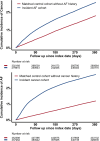Coexisting atrial fibrillation and cancer: time trends and associations with mortality in a nationwide Dutch study
- PMID: 38619538
- PMCID: PMC11231645
- DOI: 10.1093/eurheartj/ehae222
Coexisting atrial fibrillation and cancer: time trends and associations with mortality in a nationwide Dutch study
Abstract
Background and aims: Coexisting atrial fibrillation (AF) and cancer challenge the management of both. The aim of the study is to comprehensively provide the epidemiology of coexisting AF and cancer.
Methods: Using Dutch nationwide statistics, individuals with incident AF (n = 320 139) or cancer (n = 472 745) were identified during the period 2015-19. Dutch inhabitants without a history of AF (n = 320 135) or cancer (n = 472 741) were matched as control cohorts by demographic characteristics. Prevalence of cancer/AF at baseline, 1-year risk of cancer/AF diagnosis, and their time trends were determined. The association of cancer/AF diagnosis with all-cause mortality among those with AF/cancer was estimated by using time-dependent Cox regression.
Results: The rate of prevalence of cancer in the AF cohort was 12.6% (increasing from 11.9% to 13.2%) compared with 5.6% in the controls; 1-year cancer risk was 2.5% (stable over years) compared with 1.8% in the controls [adjusted hazard ratio (aHR) 1.52, 95% confidence interval (CI) 1.46-1.58], which was similar by cancer type. The rate of prevalence of AF in the cancer cohort was 7.5% (increasing from 6.9% to 8.2%) compared with 4.3% in the controls; 1-year AF risk was 2.8% (stable over years) compared with 1.2% in the controls (aHR 2.78, 95% CI 2.69-2.87), but cancers of the oesophagus, lung, stomach, myeloma, and lymphoma were associated with higher hazards of AF than other cancer types. Both cancer diagnosed after incident AF (aHR 7.77, 95% CI 7.45-8.11) and AF diagnosed after incident cancer (aHR 2.55, 95% CI 2.47-2.63) were associated with all-cause mortality, but the strength of the association varied by cancer type.
Conclusions: Atrial fibrillation and cancer were associated bidirectionally and were increasingly coexisting, but AF risk varied by cancer type. Coexisting AF and cancer were negatively associated with survival.
Keywords: Atrial fibrillation; Incidence; Mortality; Neoplasms; Prevalence.
© The Author(s) 2024. Published by Oxford University Press on behalf of the European Society of Cardiology.
Figures








References
-
- Hindricks G, Potpara T, Dagres N, Arbelo E, Bax JJ, Blomstrom-Lundqvist C, et al. 2020 ESC guidelines for the diagnosis and management of atrial fibrillation developed in collaboration with the European Association for Cardio-Thoracic Surgery (EACTS): the task force for the diagnosis and management of atrial fibrillation of the European Society of Cardiology (ESC) developed with the special contribution of the European Heart Rhythm Association (EHRA) of the ESC. Eur Heart J 2021;42:373–498. 10.1093/eurheartj/ehaa612 - DOI - PubMed
-
- Dagenais GR, Leong DP, Rangarajan S, Lanas F, Lopez-Jaramillo P, Gupta R, et al. Variations in common diseases, hospital admissions, and deaths in middle-aged adults in 21 countries from five continents (PURE): a prospective cohort study. Lancet 2020;395:785–94. 10.1016/S0140-6736(19)32007-0 - DOI - PubMed
MeSH terms
LinkOut - more resources
Full Text Sources
Medical

